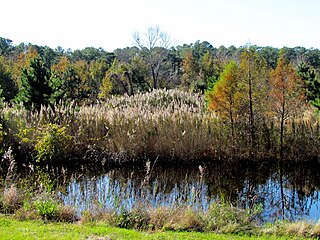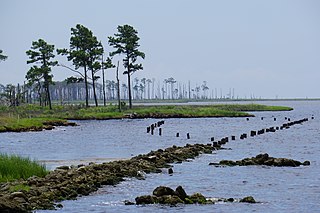Related Research Articles

Hyde County is a county located in the U.S. state of North Carolina. As of the 2020 census, the population was 4,589, making it the second-least populous county in North Carolina. Its county seat is Swan Quarter. The county was created in 1705 as Wickham Precinct. It was renamed Hyde Precinct in 1712 and gained county status in 1739.

Swan Quarter is an unincorporated community and census-designated place (CDP) in Hyde County, North Carolina, United States. It is the county seat of Hyde County. As of the 2010 census, it had a population of 324.
The Stewart B. McKinney National Wildlife Refuge is a 950-acre (384.5 ha) National Wildlife Refuge in ten units across the U.S. state of Connecticut. Located in the Atlantic Flyway, the refuge spans 70 miles (110 km) of Connecticut coastline and provides important resting, feeding, and nesting habitat for many species of wading birds, shorebirds, songbirds and terns, including the endangered roseate tern. Adjacent waters serve as wintering habitat for brant, scoters, American black duck, and other waterfowl. Overall, the refuge encompasses over 900 acres (364.2 ha) of barrier beach, intertidal wetland and fragile island habitats.

The J. N. "Ding" Darling National Wildlife Refuge is part of the United States National Wildlife Refuge System, located in southwestern Florida on Sanibel Island in the Gulf of Mexico. "Ding" Darling Wildlife Society (DDWS), a non-profit Friends of the Refuge organization, supports environmental education and services at the J.N. "Ding" Darling National Wildlife Refuge. It is named after the cartoonist Jay Norwood "Ding" Darling.

The Pocosin Lakes National Wildlife Refuge is located in North Carolina's Inner Banks on the Albemarle-Pamlico Peninsula in Hyde, Tyrrell, and Washington Counties, North Carolina. Its headquarters is located in Columbia.
Barren Island is small, uninhabited landmass in the Chesapeake Bay, just off the coast of Dorchester County, Maryland. It is located at 38°20′4.13″N76°15′11.44″W. It is known to be a mute swan nesting ground.

The Mattamuskeet National Wildlife Refuge is a federally protected wildlife refuge located within Hyde County, North Carolina, United States. North Carolina's largest natural lake, Lake Mattamuskeet, is located entirely within the National Wildlife Refuge. The refuge has a total area of 50,173 acres (203.04 km2).

The Swanquarter National Wildlife Refuge is located in Hyde County, North Carolina near the village of Swan Quarter. The area is a federally protected land and home to many species of wildlife and waterfowl. The refuge is administered from the nearby Mattamuskeet National Wildlife Refuge. The refuge has a total area of 16,411 acres (66.41 km2).
The Harbor Island National Wildlife Refuge is a 695-acre (281 ha) horseshoe-shaped island and National Wildlife Refuge in Potagannissing Bay north of Drummond Island in the U.S. state of Michigan. The island was acquired in 1983 by the United States Fish and Wildlife Service from its previous owner, The Nature Conservancy, and set aside as a refuge. It is located in Drummond Township, in Chippewa County.

Blue Ridge National Wildlife Refuge is located in the Sierra Nevada, in Tulare County, California. The refuge is one of four units of the Hopper Mountain National Wildlife Refuge Complex for California condors.

The Mashpee National Wildlife Refuge is a National Wildlife Refuge in the state of Massachusetts. Established in 1995, it is administered by the Eastern Massachusetts National Wildlife Complex. The refuge includes a surface area of 537.12 acres (2.1736 km2) managed by U.S. Fish and Wildlife Service. The refuge encompasses a total of 5,971 acres (24.16 km2), as established by the United States Congress.

The Elizabeth A. Morton National Wildlife Refuge is a 187-acre (76 ha) National Wildlife Refuge in Noyack, New York. Much of the refuge is situated on a peninsula surrounded by Noyack and Little Peconic bays. The refuge is managed by the United States Fish and Wildlife Service as part of the Long Island National Wildlife Refuge Complex.

The Sayville National Wildlife Refuge is a 127-acre (51 ha) National Wildlife Refuge (NWR) located in West Sayville, New York about two miles (3.2 km) inland from the Great South Bay. Sayville NWR is managed by the U.S. Fish and Wildlife Service as a sub-unit of Wertheim National Wildlife Refuge and part of the Long Island National Wildlife Refuge Complex. It is the only land-locked refuge in the complex.
The Big Island National Wildlife Refuge Complex is a protected wildlife refuge administered by the U.S. Fish and Wildlife Service located on Hawaiʻi Island in the state of Hawaii. It consists of Hakalau Forest on the windward side of Mauna Kea and Kona Forest on the western side of Mauna Loa.
Long Island National Wildlife Refuge Complex is a National Wildlife Refuge complex in the state of New York. All of the component refuges are located on Long Island.
Swanquarter Wilderness was designated in 1976, and it covers 8,785 acres (36 km2) in the Swanquarter National Wildlife Refuge in eastern North Carolina.
The North Carolina Coastal Plain National Wildlife Refuge Complex is an administrative organization that manages U.S. Fish and Wildlife Service wildlife refuges in eastern North Carolina. The complex includes"
The South Carolina Lowcountry National Wildlife Refuge Complex is an administrative organization that manages U.S. Fish and Wildlife Service wildlife refuges in eastern South Carolina. The complex includes:
Washington Maritime National Wildlife Refuge Complex is an administrative grouping of six National Wildlife Refuges in Washington, managed by the United States Fish and Wildlife Service. It includes:
References
- ↑ "About the Complex". Mattamuskeet National Wildlife Refuge. U.S. Fish and Wildlife Service. Retrieved September 18, 2016.